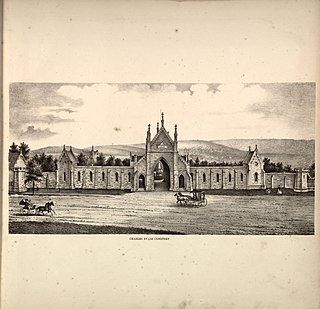
Frederick Augustus Conrad Muhlenberg was an American minister and politician who was the first speaker of the United States House of Representatives and the first dean of the United States House of Representatives. A member of the Federalist Party, he was delegate to the Pennsylvania state constitutional convention and a member of the U.S. House of Representatives from Pennsylvania and a Lutheran pastor by profession, Muhlenberg was born in Trappe, Pennsylvania. His home, known as the Speaker's House, is now a museum and is currently undergoing restoration to restore its appearance during Muhlenberg's occupancy.

Simon Cameron was an American businessman and politician who represented Pennsylvania in the United States Senate and served as United States Secretary of War under President Abraham Lincoln at the start of the American Civil War.

Joseph Ritner was the eighth governor of Pennsylvania, and was a member of the Anti-Masonic Party. Elected governor during the 1835 Pennsylvania gubernatorial election, he served from 1835 to 1839.

David Rittenhouse Porter was the ninth governor of Pennsylvania. Voted into office during the controversial 1838 Pennsylvania gubernatorial election, which was characterized by intense anti-Masonic and anti-abolitionist rhetoric during and after the contest that sparked the post-election Buckshot War, he served as the state's chief executive officer from 1839 to 1845.

William Fisher Packer was an American politician from Pennsylvania who served as the 14th governor of Pennsylvania from 1858 to 1861.

Amos Ellmaker was a U.S. politician, attorney, and judge from Pennsylvania. He served as the Pennsylvania Attorney General and was the Anti-Masonic vice presidential candidate in the 1832 presidential election.

The Muhlenberg family created a United States political, religious, and military dynasty that was primarily based in the Commonwealth of Pennsylvania, but which had also expanded into the State of Ohio by the early nineteenth century.

Henry Augustus Philip Muhlenberg was an American political leader and diplomat. He was a member of the Muhlenberg family political dynasty.

Isaac Ellmaker Hiester was a nineteenth century American political leader. A member of the Hiester Family political dynasty, he was also descended from the prominent Ellmaker family. The son of William Hiester, he was also a cousin of Hiester Clymer.

John Andrew Shulze was a Pennsylvania political leader and the sixth governor of Pennsylvania. He was a member of the Muhlenberg family political dynasty.

Gotthilf Heinrich Ernst Muhlenberg was an American clergyman and botanist.
Matthias Richards was a member of the United States House of Representatives from Pennsylvania.

Robert Coleman was an American industrialist and politician who became Pennsylvania's first millionaire.

John Weiss Forney was an American newspaper publisher and politician. He was clerk of the United States House of Representatives from 1851 through 1856, and again from 1860 through 1861. He was thereafter secretary of the United States Senate from 1861 through 1868.

Jacob Eichholtz (1776–1842) was an early American painter, known primarily for his portraits in the Romantic Victorian tradition. Born in Lancaster, Pennsylvania in a family of prosperous Pennsylvania Germans, he spent most of his professional life in Philadelphia. A coppersmith by trade, he turned to painting and achieved both recognition and success despite being mainly self-taught as an artist. He is known to have painted over 800 portraits over the course of 35 years. Hundreds of his works are housed in art museums, historical societies, and private collections throughout the United States.

Oaklands Cemetery is a rural cemetery founded in 1854 in West Goshen Township, Pennsylvania. It is located at 1042 Pottstown Pike and is approximately 26 acres (0.11 km2) in size.
June N. Honaman was an American government official. A Republican member of the Pennsylvania House of Representatives, she became the second woman ever to represent Lancaster County in the Pennsylvania State Legislature when she was elected to represent Pennsylvania's 97th district in 1976 and then also became the first woman in the history of the House to chair the Military and Veterans Affairs Committee.

The 1838 Pennsylvania gubernatorial election was a statewide contest for the office of Governor of the Commonwealth of Pennsylvania in the United States.
William Hiester Jr. was an American politician from Pennsylvania who served as an Anti-Masonic member of the United States House of Representatives for Pennsylvania's 4th congressional district from 1831 to 1837.

Charles Evans Cemetery is an historic, nonsectarian, garden-style cemetery located in the city of Reading, Pennsylvania. It was founded by Charles Evans (1768-1847), a son of Quaker parents and native of Philadelphia who became a prominent attorney and philanthropist in Reading during the late 18th and early 19th centuries.


















